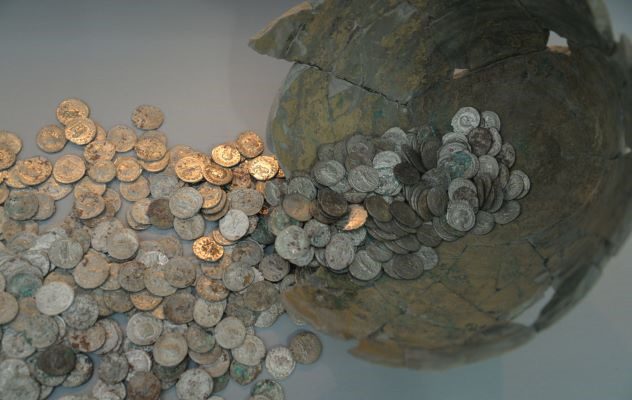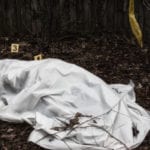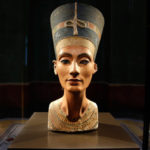 Technology
Technology  Technology
Technology  Humans
Humans 10 Everyday Human Behaviors That Are Actually Survival Instincts
 Animals
Animals 10 Animals That Humiliated and Harmed Historical Leaders
 History
History 10 Most Influential Protests in Modern History
 Creepy
Creepy 10 More Representations of Death from Myth, Legend, and Folktale
 Technology
Technology 10 Scientific Breakthroughs of 2025 That’ll Change Everything
 Our World
Our World 10 Ways Icelandic Culture Makes Other Countries Look Boring
 Misconceptions
Misconceptions 10 Common Misconceptions About the Victorian Era
 Mysteries
Mysteries 10 Strange Unexplained Mysteries of 2025
 Miscellaneous
Miscellaneous 10 of History’s Most Bell-Ringing Finishing Moves
 Technology
Technology Top 10 Everyday Tech Buzzwords That Hide a Darker Past
 Humans
Humans 10 Everyday Human Behaviors That Are Actually Survival Instincts
 Animals
Animals 10 Animals That Humiliated and Harmed Historical Leaders
Who's Behind Listverse?

Jamie Frater
Head Editor
Jamie founded Listverse due to an insatiable desire to share fascinating, obscure, and bizarre facts. He has been a guest speaker on numerous national radio and television stations and is a five time published author.
More About Us History
History 10 Most Influential Protests in Modern History
 Creepy
Creepy 10 More Representations of Death from Myth, Legend, and Folktale
 Technology
Technology 10 Scientific Breakthroughs of 2025 That’ll Change Everything
 Our World
Our World 10 Ways Icelandic Culture Makes Other Countries Look Boring
 Misconceptions
Misconceptions 10 Common Misconceptions About the Victorian Era
 Mysteries
Mysteries 10 Strange Unexplained Mysteries of 2025
 Miscellaneous
Miscellaneous 10 of History’s Most Bell-Ringing Finishing Moves
10 Amazing Viking Treasures That Have Been Found
In AD 793, a disaster came to the isle of Lindisfarne from across the sea. One account describes how “heathens desecrated God’s sanctuaries, and poured the blood of saints within the compass of the altar, destroyed the house of our hope, trampled the bodies of saints in God’s temple like animal dung in the street.” The Vikings had come. These raiders plundered valuables wherever they found them. But conversely, their treasure hunting has left us valuable clues to the past.
Here are ten Viking-era hoards that have revealed much about life at the time.
Related: 10 Amazing Viking Inventions And Innovations
10 Galloway Hoard
The Galloway Hoard, discovered in Scotland in 2014, is one of the richest hoards from the Viking era that has ever been unearthed. After metal detectorist Derek McLennan uncovered a silver armband, archaeologists were called in, and they excavated a trove of over 100 objects. Alongside large amounts of silver bullion were decorated gold pieces, broaches of a type that had never been seen before, decorative glass beads, a vessel carved from rock crystal, and a bird-shaped pin.
As well as the obviously valuable pieces, there was evidence of how they were stored. Scraps of wool and silk had been used to wrap the objects. These were treasured objects, so how did they end up in the ground? Because the objects are a mix of typically “Viking” and Anglo-Saxon artifacts, it is not clear who buried them. Were they booty from a successful raid? Was it a British person burying their wealth to keep it from being stolen?
One of the silver pieces was a broken-up armband. Most silver armbands are thought to be Norse in origin, but this one is marked in British runes with the Old English name Egbert.[1]
9 Vale of York Hoard
When two metal detectorists uncovered the remains of a lead chest in 2007, they had no idea what they were about to stumble on. As they dug a hole, something fell out of the side of the excavation. Seeing glints of silver, they did not pour out the treasure immediately but instead reported it to archaeologists. When the object was cleaned, it was revealed to be a silver vessel lined with gold crammed full of more silver objects.
In total, nearly 700 coins and other pieces of silver were recovered. The vessel they were held in was a richly decorated cup that closely resembled one already in the British Museum. Both were probably made in the same Carolingian workshop in the 10th century. Many of the coins inside were new types that had not been seen before.
What is most interesting about the hoard is what it reveals about how objects traveled during this period. Objects from North Africa, Afghanistan, Russia, Scandinavia, and Ireland were all found in a vessel from France, demonstrating how vast the Norse trade network was.[2]
8 Hoen Hoard
The Hoen Hoard is the largest collection of Viking-era gold ever discovered. Found in 1875 when a trench was being dug on a farm in Norway, it contains 207 objects. These included finger rings, neck rings, arm rings, a necklace of glass beads, and coins that have been modified so they can be hung around the neck.
Interestingly, the objects found span 500 years of history. The oldest coin was a Roman one issued around AD 360, while the last was minted at the end of the 9th century. Objects of value could be treasured for generations, it seems. Many of the objects seem to have come from France.
The purpose of burying this hoard is not known, but one theory suggests it represents the wealth of a woman who had invested in a Viking raid. The objects in this hoard, including the female jewelry, may have been her cut of the wealth brought back by the raiders.[3]
7 Herefordshire Hoard
The fate of the Herefordshire hoard is a prime example of why important archaeological finds should be reported to responsible authorities. When metal detectorists found this hoard in 2015, they took it and began selling the objects to dealers. Instead of a complete collection of unique finds, experts have only a few items that have been recovered.
The objects that have been returned are stunning. They include 30 silver coins, a golden pendant holding a sphere of rock crystal, and a silver ingot. One of the coins was an incredibly rare one dating from the reign of Alfred the Great. Other objects could have revealed more about the political and artistic state at the time.
Police investigated after rumors of a large hoard being uncovered and rare and valuable coins began to emerge with dealers. They found photos by the detectorists, which suggest the original hoard contained at least 300 coins. When complete, it was probably valued at £12 million. The detectorists would have been able to claim half of this amount if they had declared the find but instead tried to sell it to keep it all. In 2019, they were jailed for several years each.[4]
6 Cuerdale Hoard
The Cuerdale Hoard is the largest Viking-era hoard ever discovered in Britain. It contains over 8,600 objects and was probably buried in the early 10th century. It was discovered in 1840 by workers who were reinforcing the banks of a river in Lancashire. The owners of the land acted quickly to ensure all the items were kept together—though the workers were allowed to keep one coin each for their discovery.
The hoard was found within a large lead chest. Among the objects were bone pins. It seems as if the objects had been placed in the chest inside small bundles of textiles that were held in place by the pins. The majority of the coins were freshly minted by the Norse. A few, however, were silver coins from the Islamic world. The location of the hoard—on a main route from Norse York to the sea—suggests that the hoard was bound for export.
That the silver was parcelled out makes some researchers think that it may have been prepared as payment when it arrived at its destination, with each person receiving their share.[5]
5 Bedale Hoard
Unlike the Herefordshire Hoard, the discoverers of the Bedale Hoard did everything right. When the metal detectorists came across silver objects while exploring a Yorkshire field, they contacted the Finds Liaison Officer, who deals with artifacts. By leaving many of the objects in the ground, they preserved the context of the hoard, which can tell archaeologists so much about the past.
The Bedale Hoard was composed of silver ingots, silver neck rings, and a sword. The ingots were found in a small area, suggesting they had once been held in a box, which had rotted away long ago. Most interesting was the pommel of the sword, which was decorated with small plaques of decorated gold.
The lack of coins in this hoard is not uncommon in Viking-era hoards. Often silver objects that have been hacked apart are found. The use of this silver bullion was common at the time and formed a large part of the Viking economy.[6]
4 Arlanda Airport Hoard

One of the largest Viking-era hoards found in Sweden helped to piece together the trade networks which crossed the world at the time. While excavating a burial mound near Arlanda Airport in Stockholm, archaeologists uncovered first one coin, then another, then 470 in total. These coins were not produced locally, however—most came from Damascus and Baghdad.
The coins date from the middle of the 9th century, which was around the beginning of the Norse importing of coins. Most experts agree that they were the product of trade by the Vikings rather than captured during raids. Some of the coins were Persian and centuries old by the time they were buried.
The burial mound where the hoard was discovered was 1,000 years older than the hoard itself. It was probably buried there as the mound was a handy marker on the landscape, and the buriers thought they would be able to locate it again. They were wrong.[7]
3 Watlington Hoard
The Watlington Hoard is not particularly large by the standards of other hoards on this list. It is important, though, because it marks an important moment in the relations between quarreling kingdoms in Britain. The Viking raiders invaded and took northern England in the 860s while Alfred the Great ruled in the south in Wessex.
The Watlington Hoard contains 13 examples of a British coin that shows Alfred alongside Ceowulf II, the ruler of Mercia. The minting of these coins was supposed to show the level of cooperation between these rulers in the face of Viking opposition. This is important as Ceowulf had long been thought of as a puppet of the Vikings. Now we know he was likely working with Alfred.[8]
2 Viggbyholm Hoard
The Viking-era hoard excavated in Viggbyholm, Sweden, contained many of the objects that you might expect from such a trove of treasures. There were twisted silver neck collars, arm rings, pearls, and silver coins made into pendants. But among the objects that had once been deposited beneath the wooden floor of a building, there was one coin that sparked the most interest.
The Normans were strongly linked to the Vikings. The name itself is derived from them being “North Men.” Yet there is surprisingly little evidence of trade between the Normans and the Norse. This coin, however, was Norman and of a type not seen since the 18th century. Because that original coin had been lost, there were some who doubted its existence—at least until one appeared here.
The rarity of Norman coins in Viking hoards is explained by the fact that they were only interested in high-quality silver. The Normans mixed copper with their silver to mint coins. The Vikings only wanted the best.[9]
1 Spillings Hoard
The largest Viking hoard ever discovered was found in 1999 on a farm near Spillings in Sweden. The field was being scanned with metal detectors as part of a TV news segment on how pillaging from archaeological sites could destroy important information on history. Once the cameras stopped rolling, the detectorists decided to carry on. Within minutes, they stumbled on a hoard of silver so large that it overloaded their detectors.
In all, three caches of silver and bronze were discovered at the site. Unfortunately, when one was taken out of the ground still intact to be x-rayed, it proved impossible. There was so much silver in the cache that the x-rays could not penetrate it. The horde contained 486 silver bangles and 14,295 coins. Most of the coins were from the Islamic world and dated from AD 539-870. Well over 100 pounds (45 kilograms) of silver were recovered.
Several of the coins were discovered to be contemporary forgeries. All the coins were high-quality silver but had been minted to give them the impression they came from elsewhere. But as long as the silver was right, it does not seem the Vikings cared too much.[10]








